

Is not available. If you’re working on a song that uses the I, IV, and V, try substituting the bVII for the V to give the progression a different feel.
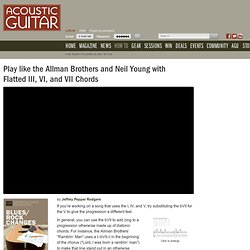
Click to enlarge. In general, you can use the bVII to add zing to a progression otherwise made up of diatonic chords. For instance, the Allman Brothers’ “Ramblin’ Man” uses a I–bVII–I in the beginning of the chorus (“Lord, I was born a ramblin’ man”) to make that line stand out in an otherwise standard country/folk progression with the diatonic I, IV, V, and vi chords. A Beginners Path to Learning Guitar. Photo by Bigstock photo So you want to learn to play guitar huh?

Or maybe you’re having trouble finding which way to go next. Well, this beginners path to learning guitar shows you where to start and how to continue on your journey. The learning path to guitar playing will not be the same for everyone. It depends on what style or genre you want to learn and your ultimate goal. Cut Your Food Spending – 8 Tips to Spend Less – beachbody.com. The page you are looking for cannot be accessed.

It may have been removed or had its name changed, or it may be temporarily unavailable. You can return to the Beachbody® home page or shopping cart. If you are having trouble ordering, please call Customer Service: 1 (800) 998-1681. SONGWRITING: Chord “moods” and emotions. Most people think of chords as something to put together in a certain order, to make your song sound like a song.

But there’s a science behind it all… an emotional science. Here are the emotions I “feel” when hearing and playing certain chord types: MAJOR – happy/poppy MINOR – sad/melancholy. Chord Progressions and moods. Practical Chord Progressions: iii (The Mediant or “Moody Chord”) In this article, we’ll be exploring the power of the iii to shift the mood of our song.

We’ll also be looking for the first time at the idea of musical phrases, questions, and answers. All of this in the form of a very simple exercise. BACKGROUND At this point, you’ve hopefully started to get a pretty solid grasp of the chords available in a single key. We have already: looked at the home chord (I), around which everything else takes on its meaning, looked at the magnet chord (V), which pulls us back toward home and reinforces its power,strengthened this sense of inevitability by building a magnetic tunnel moving from ii to V and finally to I, andexplored other mini-centers in the neighboring IV and the more mysterious vi. Rhombus: Its Properties, Shape, Diagonals, Sides and Area Formula. Sides, Angles and Diagonals A rhombus is a type of parallelogram, and what distinguishes its shape is that all four of its sides are congruent.
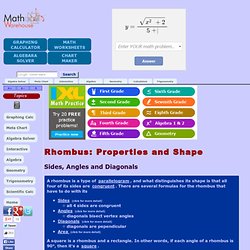
There are several formulas for the rhombus that have to do with its Sides (click for more detail) all 4 sides are congruent Angles(click for more detail) diagonals bisect vertex angles Diagonals (click for more detail) diagonals are pependicular Area (click for more detail) A square is a rhombus and a rectangle. In other words, if each angle of a rhombus is 90°, then it's a square. Probalby the most famous rhombus out there is the baseball diamond. The distance between each base is the same, making the shape a rhombus! Rhombus Sides What must be the value of x if side BA = 5x-11 and side AD = 6x-18? Guitar Tricks - What to Do When You Hit a Plateau: Tips for Getting Unstuck. When you first pick up the guitar, you spend considerable time learning the basics.
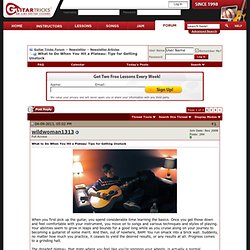
Once you get those down and feel comfortable with your instrument, you move on to songs and various techniques and styles of playing. Guitar Strength: Pushing Through Practice Plateaus in Under 7 Minutes. The art of properly practicing technical passages on the guitar has many parallels to athletic training in its way, as it is a physical endeavor requiring repetition and focused execution of muscular movements with the goal of consistent improvement.
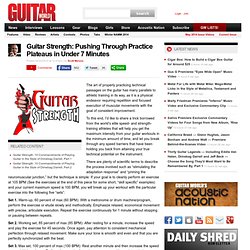
To this end, I’d like to share a trick borrowed from the world’s elite speed- and strength-training athletes that will help you get the maximum intensity from your guitar workouts in the minimum amount of time, and let you break through any speed barriers that have been holding you back from attaining your true technical potential on the instrument. Set 1. Warm-up, 60 percent of max (60 BPM): With a metronome or drum machine/program, perform the exercise or etude slowly and methodically. Emphasize relaxed, economical movement with precise, articulate execution. Repeat the exercise continuously for 1 minute without stopping or pausing between repeats. Set 2. Set 3. Set 4. Set 5. » Pushing Through a Learning Plateau on Guitar j2jenkins. Last week I shared some of the conventional wisdom for pushing through a learning plateau and this week I want to share how I applied that wisdom to tackle my own learning plateau on guitar.
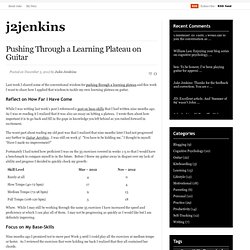
Reflect on How Far I Have Come While I was writing last week’s post I referenced a post on base-skills that I had written nine months ago. Intermediate guitar player plateau. Looking for tips. - JGuitar Answers. An intermediate guitarist should have a solid understanding of the basic mechanics of playing the guitar.
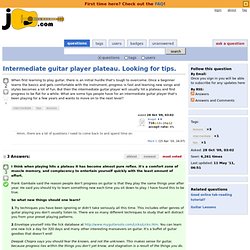
The basics of playing the guitar are: chords (harmony), scales (melody), and rhythm (rhythm being the most important and universal of the three). There are also the important aspects of: form (common song structure), dynamics (loud, or soft), and timbre (tone, effects, etc.). This involves creating some logic of why things go together, or learning some music theory. Once all of these are familiar; there are two general directions that an intermediate guitarist can go: Improvising or playing composed music. The two are not mutually exclusive, but different styles of music require different levels of each. Creativeguitarstudio. Intermediate guitar player plateau. Looking for tips. - JGuitar Answers.